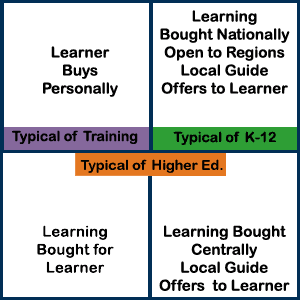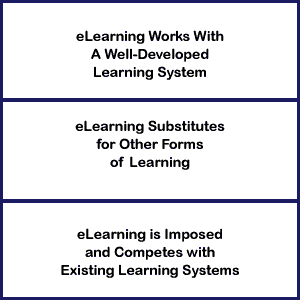Cube Introductions
Cube Introductions: 1 Face at a Time
The terms “learning technology” and “e-learning” are facile – we think we know what we’re talking about when we use them, but the reality of trying to make a living from it is far more complex. Hence, the ETEC 522 “cube” – a way of looking at the learning technology business space both in terms of the subdivisions that make it up, and in terms of its relationships.
Here we introduce the cube. There are actually more than six dimensions that we could have used, but these six best describe the learning technology space both from an entrepreneurial and an institutional point of view.
Most people display learning technology in a two dimensional matrix, by type of market (K-12, higher education, commercial) crossed by type of offering (services, content or infrastructure). These are our first two faces. We then add to the mix:
- Who is the buyer? – because learners don’t often choose their own learning technology products.
- What piece(s) of the global market are we talking about – because learning technology doesn’t always “go” everywhere the Internet does.
- How developed is the local market? – because the sweet spot for success is in the middle of the development curve.
- How integrated is learning technology with the rest of the educational system – because without that integration learning technology struggles.
Face 1: Market Focus
Public Schools (K-12)
The public school system forms an obvious market for many companies that see the opportunity to equalize classroom education across a country or region by using learning technology to bring the same materials to all schools. Some of the greatest successes in this area have occurred in less developed countries investing in education.
Higher Education
Higher education is increasing its adoption of learning technologies but has stimulated only a limited set of companies to aim their products and services at universities and colleges. Some academic institutions have instead spawned commercial ventures of their own, such as WebCT (founded at UBC and now owned by Blackboard.com) and Desire2Learn (initiated at the University of Waterloo, and now a corporate entity, Desire2.Learn.com)
Training Needs (Trades Training, Corporate, Consumer)
The corporate market (for training employees) has created the world’s largest learning technology companies and remains an attractive market for new entrants. A growing number of products are aimed at consumers using e-commerce facilities. Trades training and apprenticeship systems are a new and emerging area.
Face 2: Types of Offerings
Services
Some learning technologycompanies provide services to their clients. These include planning, designing customized content and then building it, evaluating the success of learning technology initiatives and designing blended learning solutions (mixtures of learning technologies and instructor-led education).
Content
Content developers build courseware that can be licensed and put to work immediately. Some organizations have their own subject matter experts; others work with independent authors to provide subject expertise in building their products. Some companies work with textbook publishers or instructor-led course developers to produce blended solutions.
Infrastructure
Infrastructure providers produce software that is used to deliver online content. These include learning management systems, such as the one you are using to take this course, to manage students and content; content management systems, used to construct new content; virtual classrooms, for distance synchronous learning, group discussion systems, and other elements that augment the learning experience.
Face 3: Who is the Buyer?
Typical of Training
The buyers on the left hand side of this face are typically found in the training market – corporate and consumer.
Typical of K-12
The buyers on the right hand side of this face are typically found in the K-12 or public education market.
Typical of Higher Ed
The buyers on the bottom half of this face are typically found in higher education situations.
Learner Buys Personally
Here the purchaser and the student are the same person. Typically solutions here are purchased through e-commerce systems. There are some higher education offerings where students enrol online, either directly with a Student Information System (SIS) or through an e-commerce facility
Learning Bought for Learner
Here the purchaser is not the same person as the student, and the purchaser may never actually use the material that is purchased. This is often found in corporate settings, or where parents buy for their children, and where a student is enrolled in a program of study and the elements are selected for them.
Learning Bought Centrally – Local Guide Offers to Learner
Here a jurisdiction – a province, state or school district – or a multinational corporation’s headquarters staff – has made the purchasing decision, that is imposed on all the schools or country subsidiaries of the company. The solution often requires local schools or country operations to provide support and implement local changes in order to create an optimal learning experience for the students.
Learning Bought Nationally – Open to Regions – Local Guide Offers
This is typical of less developed countries that acquire learning technology via international financial institution support (e.g. the Asian Development Bank, African Development Bank). Once the purchase is made, the regions of the country may (or may not) take it up. If they do, for the region, it is much like “Learning Bought Centrally”.
Some multinational corporations operate this way as well – country operations have access to global purchase agreements, but need not use the “headquarters” solution.
Face 4 – Global Markets
Wired Anglophone Countries
These are countries with both excellent Internet infrastructure and English as a first language (most commercial learning technology globally is built in English). Examples would be Canada, the USA, Australia, the UK, Ireland and New Zealand.
“European” Countries with Language Skills
These are countries with excellent Internet infrastructure and where English is not only taught as a second language but readily used. Typically, these countries sub-title entertainment rather than dub it. Examples are many western European Union (EU) countries and South Africa.
European Countries Requiring Translation
These are countries with excellent Internet infrastructure but where English is a second language learned in school and not readily used. Typically, these countries dub entertainment rather than sub-title it. Examples are found in Latin America, eastern Europe, France, Italy, Spain and Portugal.
Asian Countries with Quality Internet
“Asian,” in this context, refers to text encoding (that leads to product revisions): right-to-left languages, or double-byte encoding requirements. Many products cannot easily be translated when a non-Western single-byte alphabet of characters is required. Nevertheless, Japan, the Republic of Korea, China, Taiwan, India, Israel and other similar countries form viable markets.
Other Regions with Restricted or Poor Quality Internet Service
Once Internet service becomes problematic, markets for learning technology begin to break down. Many countries – including Canada – still have regions where learning technology is not pervasive, or where “last kilometre” issues exist. Much of Africa and Central Asia cannot easily support learning technology, as well as the interior of China. Cost can be as much a limiting factor as line quality or national firewalls.
Special Situations
Certain situations – military units, Antarctic bases, maritime requirements – as well as marginal languages also create problematic markets for learning technology, although it is quite common to use information technology infrastructure to arrange for the shipment of materials to these types of remote locations.
Face 5 – Development of the Market
Market Does Not Support Learning Technologies
For reasons of poverty, marginal languages, poor or restricted Internet infrastructure or geographic isolation, the target market cannot support learning technology ventures of any type that will be viable businesses. Any solutions will be funded by international financial institutions, or by grants from developed countries.
Market Only Supports Custom Work or Indigenous Suppliers
For reasons (typically) of language or national policy, the market for externally-sourced learning technologies is limited. Custom work allows for products to be built (perhaps from anywhere in the world), but national policies favour the creation of indigenous suppliers only.
Market Supports Import of Content & Infrastructure
The market freely imports both content and infrastructure. Local businesses in learning technologies tend to be concentrated in services work only. The market does not produce products for export.
Market Supports Export Oriented Learning Technologies and Substitution of Imports
The market freely imports content and infrastructure. Local companies also produce similar products for export, as well as providing local services. In some cases, local products replace previously-imported products, either due to better localization of content, or because of a price advantage.
Face 6 – Learning Technology Competing with Other Forms of Learning
Learning Technology Works With a Well-Developed Learning System
There is already a well-developed learning system in the sector (e.g. instructor-led courses, teachers in schools, etc.) and learning technology has been fitted into the mix (e.g. to handle home schooling, to extend the reach of universities to rural communities, to handle upgrading of credentials for employees, etc.)
Learning Technology Substitutes for Other Forms of Learning
By policy decision, learning technology is displacing other forms of learning. This may be for reasons of cost (in a corporate setting) or because the existing learning solutions are not working (e.g. rural public schools in less developed nations). As learning technology is not the “best” solution in all cases, gaps in learning performance persist.
Learning Technology is Imposed, and Competes with Existing Learning Systems
By policy decision, learning technology has been imposed on the system (e.g. policy requiring all learning objectives to be available through learning technologies for distance learners and attracting student grants in response, or a headquarters corporate policy for learning technologies when subsidiaries or business units have existing instructor-led training relationships). The existing learning system is not fitted to work with the learning technology components, and tensions exist between practitioners and consumers of the two modes.
Activity: Pick a company in the e-learning domain, or an e-learning product with which you are familiar and comment on some aspects of its market niche using the Cube as a guide. Share your insights in the discussion space of the course blog for Module 3.







